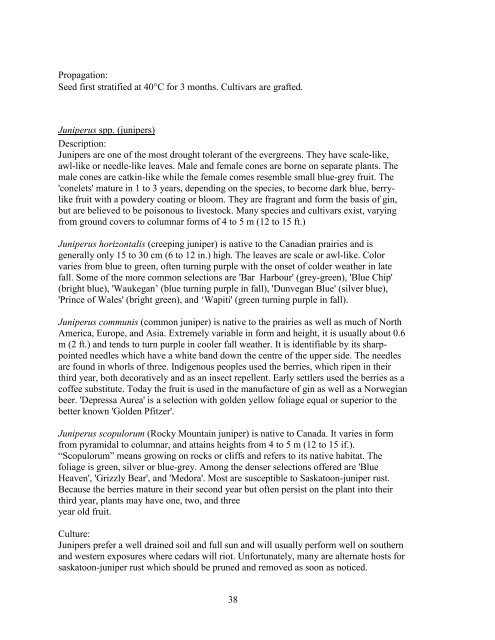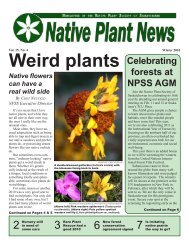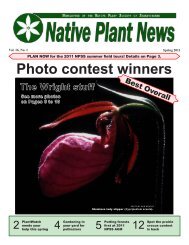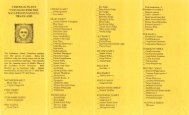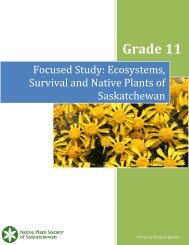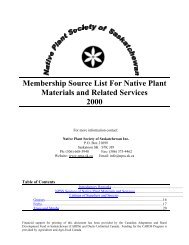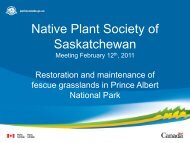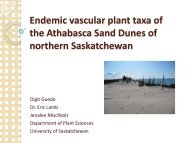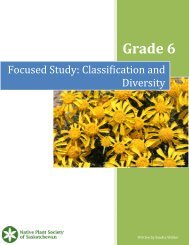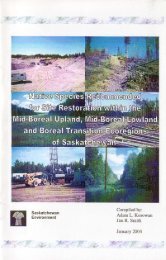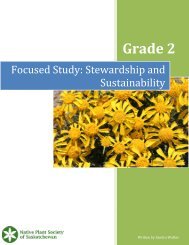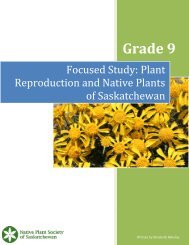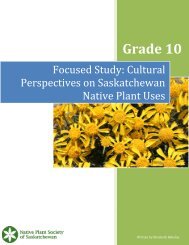Native Plants As Habitat For Wildlife - Native Plant Society of ...
Native Plants As Habitat For Wildlife - Native Plant Society of ...
Native Plants As Habitat For Wildlife - Native Plant Society of ...
You also want an ePaper? Increase the reach of your titles
YUMPU automatically turns print PDFs into web optimized ePapers that Google loves.
Propagation:<br />
Seed first stratified at 40°C for 3 months. Cultivars are grafted.<br />
Juniperus spp. (junipers)<br />
Description:<br />
Junipers are one <strong>of</strong> the most drought tolerant <strong>of</strong> the evergreens. They have scale-like,<br />
awl-like or needle-like leaves. Male and female cones are borne on separate plants. The<br />
male cones are catkin-like while the female comes resemble small blue-grey fruit. The<br />
'conelets' mature in 1 to 3 years, depending on the species, to become dark blue, berrylike<br />
fruit with a powdery coating or bloom. They are fragrant and form the basis <strong>of</strong> gin,<br />
but are believed to be poisonous to livestock. Many species and cultivars exist, varying<br />
from ground covers to columnar forms <strong>of</strong> 4 to 5 m (12 to 15 ft.)<br />
Juniperus horizontalis (creeping juniper) is native to the Canadian prairies and is<br />
generally only 15 to 30 cm (6 to 12 in.) high. The leaves are scale or awl-like. Color<br />
varies from blue to green, <strong>of</strong>ten turning purple with the onset <strong>of</strong> colder weather in late<br />
fall. Some <strong>of</strong> the more common selections are 'Bar Harbour' (grey-green), 'Blue Chip'<br />
(bright blue), 'Waukegan’ (blue turning purple in fall), 'Dunvegan Blue' (silver blue),<br />
'Prince <strong>of</strong> Wales' (bright green), and ‘Wapiti' (green turning purple in fall).<br />
Juniperus communis (common juniper) is native to the prairies as well as much <strong>of</strong> North<br />
America, Europe, and <strong>As</strong>ia. Extremely variable in form and height, it is usually about 0.6<br />
m (2 ft.) and tends to turn purple in cooler fall weather. It is identifiable by its sharppointed<br />
needles which have a white band down the centre <strong>of</strong> the upper side. The needles<br />
are found in whorls <strong>of</strong> three. Indigenous peoples used the berries, which ripen in their<br />
third year, both decoratively and as an insect repellent. Early settlers used the berries as a<br />
c<strong>of</strong>fee substitute. Today the fruit is used in the manufacture <strong>of</strong> gin as well as a Norwegian<br />
beer. 'Depressa Aurea' is a selection with golden yellow foliage equal or superior to the<br />
better known 'Golden Pfitzer'.<br />
Juniperus scopulorum (Rocky Mountain juniper) is native to Canada. It varies in form<br />
from pyramidal to columnar, and attains heights from 4 to 5 m (12 to 15 if.).<br />
“Scopulorum” means growing on rocks or cliffs and refers to its native habitat. The<br />
foliage is green, silver or blue-grey. Among the denser selections <strong>of</strong>fered are 'Blue<br />
Heaven', 'Grizzly Bear', and 'Medora'. Most are susceptible to Saskatoon-juniper rust.<br />
Because the berries mature in their second year but <strong>of</strong>ten persist on the plant into their<br />
third year, plants may have one, two, and three<br />
year old fruit.<br />
Culture:<br />
Junipers prefer a well drained soil and full sun and will usually perform well on southern<br />
and western exposures where cedars will riot. Unfortunately, many are alternate hosts for<br />
saskatoon-juniper rust which should be pruned and removed as soon as noticed.<br />
38


